The detailed nature of aquaculture activities is hard to typify due to the great diversity of farming practices both among and within countries in Asia and Europe.
At a glance, two species groups dominate aquaculture production in the two regions, carps in Asia and salmonids in Europe, and this will continue if current trends in growth continue. In addition to salmonids, marine (coastal) finfish make a significant contribution in terms of value in Europe. In Asia, carps, including barbels, and other cyprinids accounted for 62 and 55 per cent of total Asian and world fed aquaculture production.
In Europe, salmon and trout contributed 50 and 74 per cent, respectively, to European total aquaculture, all fish farmed with commercial feeds. This species group dominance in fed aquaculture in both regions and the recent focus on crustaceans, marine finfish, and other diadromous fishes point towards a tendency of increasing reliance on commercial aquafeeds for their production. Although carps are considered low-value species and are mainly fed farm-made aquafeeds (usually single ingredient feeds), their bulk production will place a heavy demand on feed ingredients, especially grains which will have to be procured on globally traded markets.
Between 2000 and 2006, the production of marine shrimps and prawns, and freshwater crustaceans in Asia increased by 183 and 121 per cent, respectively (Table 8), and in Europe, diadromous fish and coastal fish (including marine fish) production increased by 18 and 35 per cent, respectively (Table 9), where feed demand is expected to be high.
It is worth noting that in the freshwater sector, the production of a number of carnivorous species has grown substantially since 2000. For example, production of pangas catfishes increased by 66.6 per cent, amur catfish by 1 005 per cent and snakeheads by 23 425 per cent. Asian mariculture is generally dominated by high-value species such as penaeid shrimps and seabreams. Of the penaeid shrimps, whiteleg shrimp production has made significant advances in recent years to move into seventh place (Table 10).
The production of other high-value species such as the oriental river prawn, giant tiger prawn, mandarin fish, Japanese amberjack and Japanese eel has also increased significantly. Thus, there is a notable move away from bulk production of low-value species and a focus on production of high-value species to meet growing demand of the local increasingly affluent populations and consequently greater pressure on sources of high-quality protein and oil.
There are a number of high-value species worth highlighting as emerging species (Table 11). Since 2000, there was rapid growth in the production of high-value carnivorous species such as whiteleg shrimp, freshwater swamp eel, mandarin fish, channel catfish, red swamp craw fish, Chinese river crab and marine finfish.
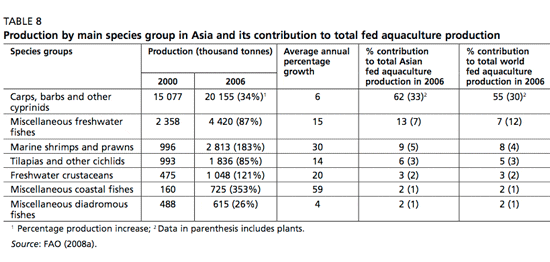
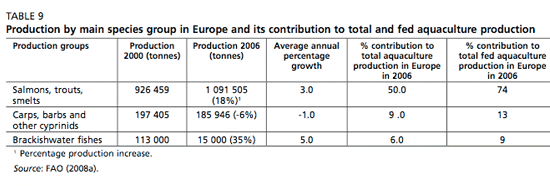
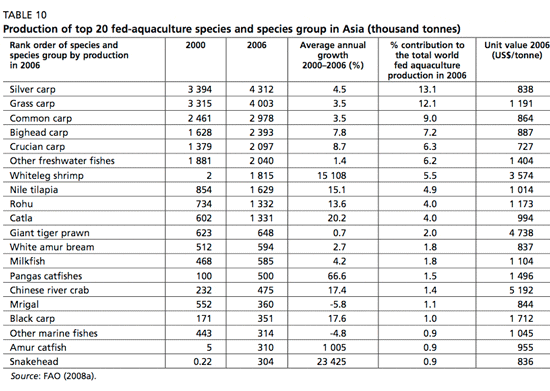
In Viet Nam, high-priced freshwater pangas catfish and marine crustaceans increased their combined contribution of 36.5 per cent (pangas catfish – 21.8 per cent, marine crustaceans – 14.7 per cent) in 2000 to 49.5 per cent (pangas catfish – 29.7 per cent, giant tiger prawn – 9.9 per cent, whiteleg shrimp – 9.9 per cent) in 2006 to total fed aquaculture production, while of other freshwater fish the contribution decreased from 57.8 to 46.8 per cent over the same period (Figure 3). Percentage contributions of the main species to aquaculture production in Thailand are presented in Figure 4.
Of the main contributing species in Thailand, production of high-priced crustaceans and carnivorous catfish increased from 15.1 per cent in 2000 to 65 per cent of the total fed aquaculture production, while the contribution of other freshwater fish remained static at around 28 per cent over the same period (Figure 4). The contribution of high-priced crustacean to total fed aquaculture production in Indonesia almost doubled from 11.5 per cent in 2000 to 22.4 per cent in 2006 (Figure 5).
Thus, marine crustaceans and carnivorous catfish have been recent major cultured species throughout the subregion. Another species worth mentioning is the Nile tilapia, which increased its share from 5.2 per cent in 2000 to 14.0 per cent in 2006 in Indonesia, while in Thailand it maintained its contribution to total fed aquaculture production at between 14 and 15 per cent over the same period.

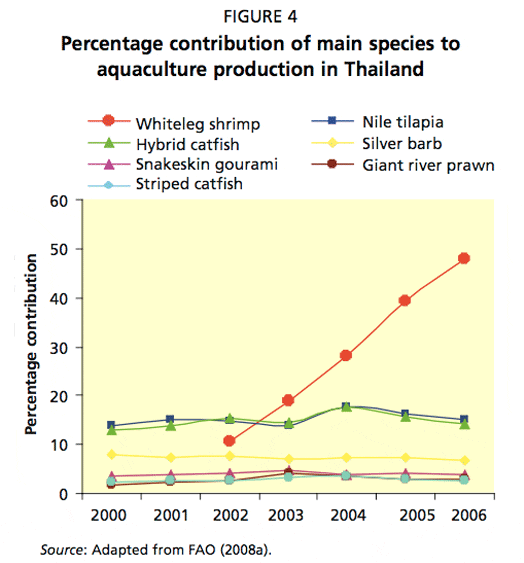
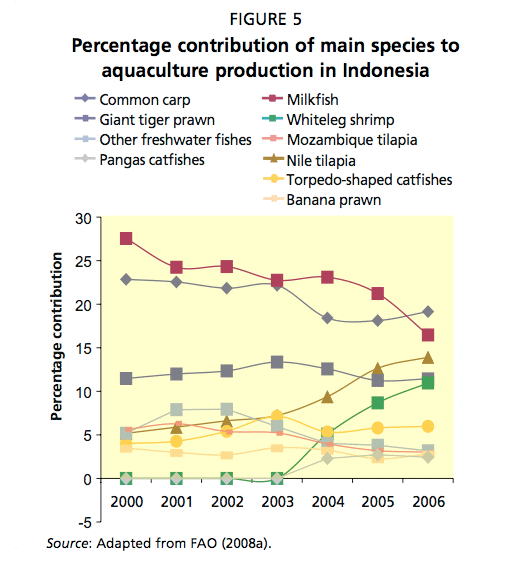
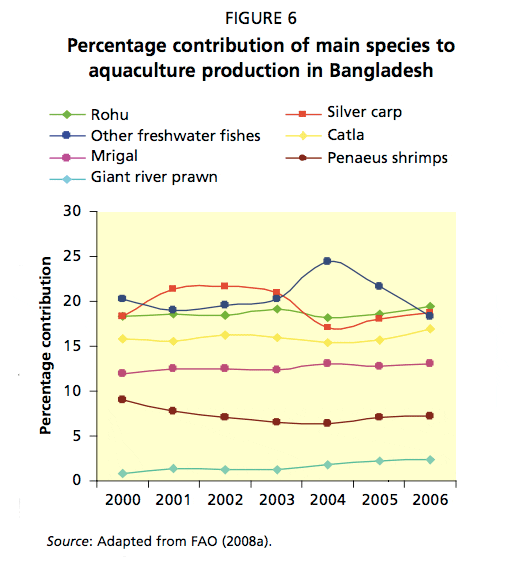
Indian carps (rohu, catla and mrigal) provide the mainstay of aquaculture production in Bangladesh and India. Bangladesh maintained a contribution between 46 and 49 per cent (Figure 6) to the total fed aquaculture production over the period 2000–2006 while India’s contribution over the same period was around 75 per cent (Figure 7).
Recent years have also witnessed a rapid increase in the production of silver carp (a 25–fold increase 2000-2006) in India. Crustacean contribution to total fed aquaculture production declined in the leading aquaculture producing countries in the subregion in recent years except in Myanmar.
In contrast to Bangladesh (59 143 tonnes in 2000 to 64 700 tonnes in 2006) and India (90 975 tonnes in 2000 to 130 155 tonnes in 2006), rapid growth in high-priced crustacean production was seen in Myanmar which recorded a 12–fold increase in production from 2000 to 2006 (from 4 964 to 60 000 tonnes) and made a 5.0 to 10.4 per cent contribution to total fed aquaculture production over the same period (Figure 8). Thus, the potential demand for performance diets in future in the subregion is localized and may not be as high as in the Southeast Asian subregion. However, the trend in switching from extensive to semi-intensive carp culture will increase the demand for feed ingredients.
Trends in intensification of aquaculture practices
Aquafeeds usually account for 50–70 per cent of production costs. Therefore, for most farming operations, the price of fish influences the expenditures for inputs such as feeds and feed ingredients. In general, low-value freshwater species are cultured in extensive or semi-intensive systems that need great volumes of water and land area, and inputs may be limited to fertilizers and single-ingredient farm-made aquafeeds. Accordingly, productivity is lower than that of higher value-species cultured in intensive systems using commercially formulated aquafeeds.
Land and water resources, however, are already in short supply in many leading aquaculture producing countries in Asia due to land tenure structures, urbanization and industrialization, and competing demand for land and water for irrigation, compounded by increasing human population.
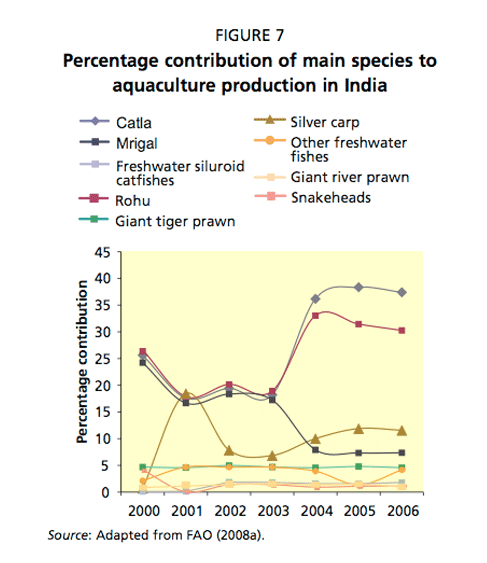
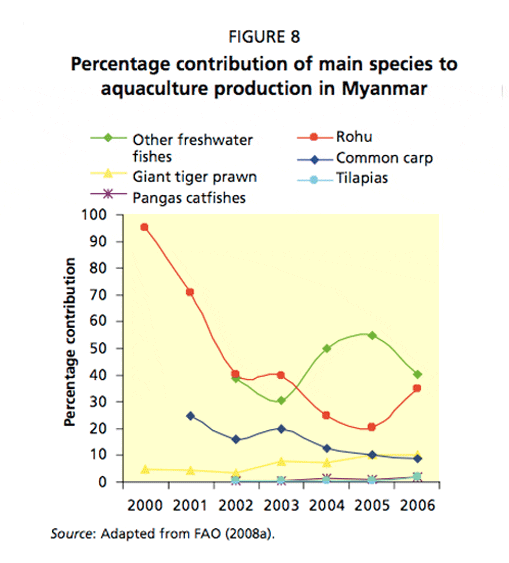
Current world aquaculture production, particularly low-value species, is heavily dependent on land-based production systems.
In China, production in ponds accounted for 77 per cent of the total inland aquaculture production (Ye, 1996). In the last decade, pond culture contributed 70–90 per cent of total freshwater aquaculture production in Thailand (WorldFish Center, 2004a). FAO (2000) reported that about 78 per cent of Indonesian farming households cultivate fish in small ponds of less than 500 m2, and aquaculture is the main source of income for 66 per cent of the households that cultivate fish in the paddies and ponds (WorldFish Center, 2004b).
The most important farming system in Viet Nam is pond polyculture commonly stocked with Chinese carps (silver carp, grass carp and bighead) in the northern region and river catfish, common carp and Indian major carps (rohu, mrigal) in the southern region (WorldFish Center, 2004c). In recent years, red tilapia is cultured in ponds by using an intensive monoculture system. In addition, an integrated VAC system (V: garden, A: fish pond, C: livestock) is also common in Viet Nam. Thus, it can be estimated that overall 70–80 per cent of freshwater aquaculture production in leading aquaculture producing countries comes from ponds and, therefore, land-based aquaculture will play an important role in future world aquaculture production.
The availability of and continued access to land as well as fish prices, however, will dictate the pace of intensification. To illustrate the challenges of meeting the projected aquaculture production in 2020 in two leading aquaculture producing countries, China and India, an increase in pond area would be on the order of 75 and 310 per cent, respectively, in 2006 (Table 12).
Similarly, procurement of water, particularly freshwater, required to expand aquaculture would be a challenge due to competing demands for freshwater by other sectors (as shown in Table 13) and increasingly limited water availability for development.
Margat (1996) estimated that fisheries (including aquaculture) as an economic sector uses water without significant consumption and, hence, water is not lost from the hydrosphere. Although in hydrological terms water consumption in aquaculture is low, in physical and qualitative terms, aquaculture may make water unavailable for other uses.
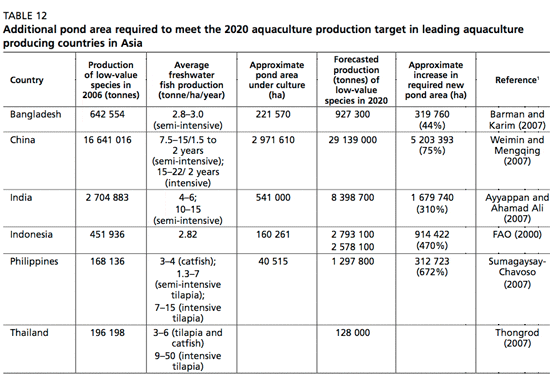
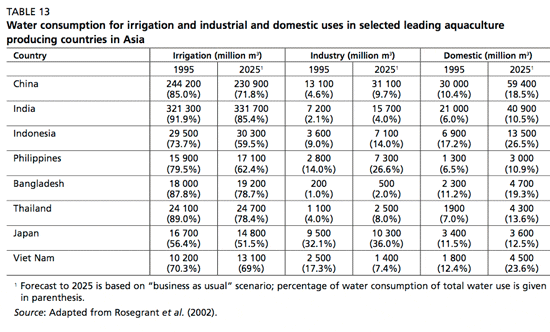
Therefore, we anticipate that aquaculture will compete with other economic users of freshwater as pressure on the national renewable water resources increases. As a rough estimate, if the critical ratio of water withdrawal exceeds a quarter of actual renewable water resources of a country, water can be considered a limiting factor to development and, reciprocally, the pressure on water resources can have a direct impact on all sectors, from agriculture to environment and fisheries (FAO, 1997).
Moreover, a high dependency ratio, meaning the proportion of water in a country that is received from external sources (see Box 1), indicates the vulnerability of a country to the effects of extraction, impoundment and pollution. A high dependency ratio will inevitably have important implications for water-sharing policies, cooperation and conflicts, while a low dependency ratio for a water-scarce nation means it has to make careful decisions on improving future internal efficiencies in water usage.
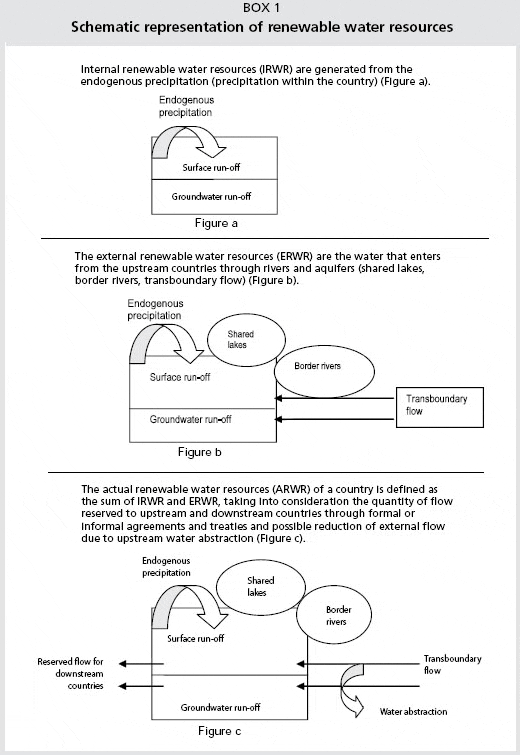
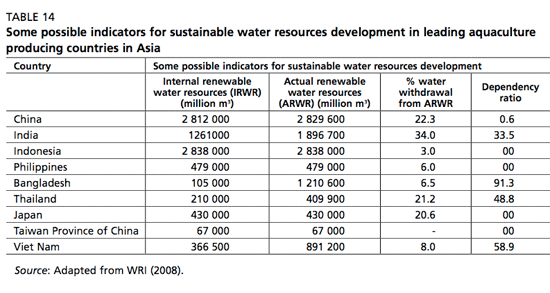
The high Percentage of the water withdrawal indicator (critical ratio) among the leading aquaculture countries in Asia, points to a possible water limiting factor for aquaculture development in China, India, Thailand and Japan and the high dependency ratio indicator for Bangladesh and Viet Nam may suggest increased competition from other sectors and countries with which they share this resource (Table 14).
In the light of probable increased competition for land and water throughout many aquaculture producing countries in Asia, there will inevitably be increasing pressure to improve productivity through intensification. This trend is already evident. The production of low-value (in marketing term) herbivore and omnivore species is changing rapidly from extensive to semi-intensive systems using low-cost farm-made aquafeeds.
This is illustrated by the recent trend in global aquafeed production and number of farms dependent on aquafeeds. In 2003, global aquafeed production was estimated at approximately 19.5 million tonnes, but it is anticipated that it would increase to over 37.0 million tonnes by the end of this decade (Barlow, 2000). According to an estimate based on the aquafeed production of the seven leading aquaculture producing countries (Bangladesh, China, India, Indonesia, the Philippines, Thailand and Viet Nam), this trend was also evident from the increase in the use of industrial aquafeeds from 10.3 million tonnes in 2003 to an estimated 22.2 million tonnes in 2013 in Asia alone (De Silva and Hasan, 2007).
It is also predicted that the usage of farm-made aquafeeds may go up over the next ten years, to 30.7 million tonnes in 2013 from 19.3 million tonnes, representing a growth of 60 per cent from the 2003 level (De Silva and Hasan, 2007). In a recent analysis based on case studies in six leading Asian aquaculture producing countries, 50–70 per cent of farms, with the exception of China, were dependent on farm-made aquafeeds.
China’s dependency was only 25 per cent. The number of semi-intensive farms depending on complete commercial feeds is highest in India (74 per cent) followed by China (46 per cent) (Rola and Hasan, 2007). China and India together accounted for 90 per cent of the world’s carp and other cyprinid production, and 92 per cent of Asia’s carp and other cyprinid production, indicating a trend towards the mainstay of low-value species but semi- intensive farming using commercial complete feeds as opposed to feeds made on-farm. These developments suggest a trend towards increasing intensification of production and consequently increasing dependency on formulated complete diets.
Further Reading
| - | You can view the full report by clicking here. |

